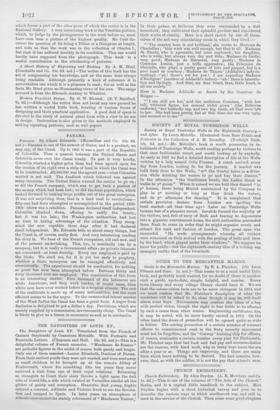SOCIETY AT ROYAL TUNBRIDGE WELLS.
Society at Royal Tunbridge Wells in the Eighteenth Century— and After. By Lewis Melville. Illustrated from Rare Prints and Portraits in the Collection of A. M. Broadley. (Eveleigh Nash. 10s. 6d. not.)—Mr. Melville's book is worth possessing by in- habitants of Tunbridge Wells, worth reading perhaps by visitors to that once fashionable resort, and worth looking at by anybody. As early as 1697 we find a detailed description of life at the Wells written by a lady named Celia Fiennes. A coach arrived every day from London, costing 8s. for the journey. A market was held daily dose to the Wells, " wok the Gentry takes as *diver- sion while drinking the waters to go and buy their dinners." In the afternoon "the Gentlemen bowie, the Ladies dance or walke in ye green." -When it rained we are told they danced "in ye houses, there being Musick maintained by the Company to play in ye morning so long as they drink the waters, and in ye afternoon for dancing." It is complained that certain provision dealers from London are spoiling the local market—all that time ago! Later on Tunbridge Wells became less of a pleasure resort. Invalids formed the majority of the visitors, and, full of envy of Bath and fearing to degenerate into a gigantic convalescent home, the civil authorities persuaded Beau Nash to come in order that he might organize revels and attract the rank and fashion of London. The great man was successful. "lie made arrangements whereby all visitors were welcomed on their arrival with the pealing of bells and then by the band, which played under their windows." We suppose he knew his public—but the eighteenth-century idea of a holiday was strangely unlike that of the twentieth.






















































 Previous page
Previous page